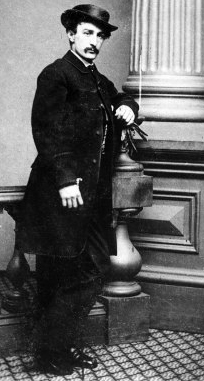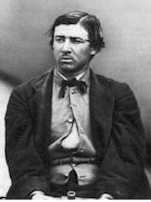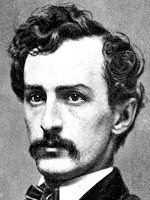Did John Wilkes Booth escape?
Did the killer of President Abraham Lincoln get away?
Booth escaped to Texas and committed suicide in Oklahoma.
That's the story, anyway, that many people believe.
The fact is... it may be absolutely true.
According to the history books,
Booth was tracked down 12 days after Lincoln's assassination
and
was shot and killed in a tobacco barn on April 26, 1865.

Descendants of the Booth family have always believed that John Wilkes escaped.
Supposedly, his brother Edwin
had actually spoken with him.
The Booth family believed back when it happened and they still believe,
that the man killed in the barn was not John Wilkes Booth.
Why were no photos taken of the body of Booth?
There should have been many photos of the dead assassin.
This is one of the main reasons why doubts about Booth's death still exist.
The fact is, one photo of John Wilkes Booth's body was taken.
Secretary of War Edwin Stanton, ordered that only one photograph would
be taken of Booth's corpse.
Stanton was adamant that Booth not become a martyr to Southern sympathizers.
Stanton had been outraged that a photo of President Lincoln's body was published by newspapers.
The photo was taken, under close observation.
Then the print and the glass plate (the negative) were turned over to
the head of the Secret Service.
It hasn't been seen since, and its whereabouts are unknown.
When the public learned that a photo of the dead Booth had been taken,
but was never seen, the
controversy and questions about the death of Booth began.
I'm saying that back in 1865,
there
were serious doubts if Booth really had been killed.
Even back then, there were questions as to just who
really
had been killed in that barn in Port Royal Virginia.
In 1877 in Texas, a man named John St. Helen was on his deathbed, or so he thought.
He confessed to an attorney friend, Finis Bates,
that he was the infamous killer of President Lincoln.
He told the story of how he had escaped.
However, St. John recovered.
He told Bates that he must have been delusional,
that there was no truth about him being the assassin of the President.
Sometime later, he left town.
In 1903, in Enid Oklahoma,
a man named David E. George killed himself by drinking arsenic.
While dying he confessed
to his landlord that he was Booth.
She reported this and the newspapers picked up on it.
The attorney, Bates, reading of this man who claimed to be Booth, traveled to Oklahoma.
When he saw the body, he immediately
recognized this as the man who had confessed to him years earlier.
Because of the arsenic (don't ask me how it happened), the body became mummified.
It was displayed for the public and then later
the mummy
appeared in carnival sideshows for many years as the body of John Wilkes Booth.

Here are two photos.
We know that the man on the right really is John Wilkes Booth.
The man on the left may also be him. That's the mystery.
In 1907, Bates wrote and published the book,
'The Escape and suicide of John Wilkes Booth'.
Who knows how much of his story was true and how much was just embellished.
His book claims that Vice President Johnson was behind the assassination.
The fact is, when you try to research something that happened 150 years ago,
you just can't believe everything that has been written by some author.
In 1931, doctors examined the mummy and found that it had
certain marks and characteristics of what was known about Booth.
The last reported time the mummy was seen was in the 1970's.
John Wilkes Booth's body (what was believed to be his), was eventually buried in the Booth family plot in Baltimore.
His descendants, and backed up by the Smithsonian Institution,
have given the okay to exhume his body and use DNA analysis
to determine if the bones belong to someone (at least in the Booth family).
However, a judge refused the request in 1995,
citing possible severe water damage to the plot and evidence
that siblings were buried on top.
Also, the judge didn't believe that Booth might have escaped justice and a cover up took place.
But, there's another way to prove things.
For whatever reason, when the autopsy was performed in 1865,
the U.S. Army
kept three vertebrae from Booth's body.
Those vertebrae are in the National Museum of Health and Medicine in Washington D.C.
The thinking is that Edwin Booth's body, buried in Massachusetts,
could be exhumed and DNA from his bones would be compared
to the vertebrae.
Edwin's family has given the okay to exhume his body.
But, the U.S. Army Medical Command is in charge of the museum and has refused,
saying that the samples needed
for the DNA test would damage the bones,
which must be kept for future generations.
Let's take a closer look at the reported death of John Wilkes Booth.
David Herold, who later was hanged, was also in the barn that night.
He surrendered to the army soldiers.
David Herold is a pivotal point.
He came out of the barn and reportedly said, "The man inside is not Booth".
We don't know if he really did say those words.
Later, he claimed that it was indeed Booth and he stuck to that story.
Why would the Smithsonian, a highly respected institution,
get involved with recommending the exhumation of a body
if it's obvious
that Herod positively identified the man in the barn as Booth?
Herold is standing there being handcuffed and being questioned.
When Booth is shot, everyone was saying that 'we got him'.
Herold realizes this is his place in history.
He was going to be the man who allowed the escape of John Wilkes Booth.
He pictured himself as a true Southern patriot.
Reportedly, some soldiers were saying, 'this doesn't look like Booth'.
Some reports have the man killed that day as
having red hair.
Booth was well known to have very black hair.
But Booth was an actor who had used makeup.
I think
it's obvious that he would have tried to disguise his appearance.
But officers ignore these words questioning if this really was John Wilkes Booth.
There have always been question marks about
just what was said and happened
in those very early hours at the Garrett farm.
There was a $100,000 reward for Booth.
That was an absolute fortune back in 1865.
It was the first time in history that an actual photograph was used on a wanted poster.

David Herold was described by his attorney during the trial
as being slow-witted with a low intelligence,
and easily influenced by Booth.
He was a braggart, but probably not dumb.
David Herold became what he considered to be a true hero of the confederacy.
Even when he realized that he had been sentenced to hang,
he continued his story that Booth had been killed.

On July 7, 1865, Herold was hung along with Lewis Powell, George Atzerodt
and Mary Surratt (the first woman hung in America).
The American people wanted revenge. There were even many people in the South who didn't
like the President being assassinated. It's well known that Booth was stunned to read the newspapers
and instead of being called a hero, he was denounced.
The people were told that the killer of the beloved President Lincoln had been found and shot to death.
Secretary of War Edwin Stanton and other government officials may have realized
that Booth got away.
There were many thousands of former soldiers with crippled legs.
Booth could have put makeup on to look like an old man with an Irish accent.
(They actually lucked out when they caught up to Booth,
assuming of course that really was him).
If officials, such as Stanton, realized that the body they had was not Booth,
it was too late.
The army had been sent home.
The search was canceled.
The American people needed to be assured that the SOB that killed the President had
been apprehended and killed.
The public could not be told the truth.
The photo was probably destroyed very shortly later.
It has disappeared completely from history.
Why would a prestigious organization such as the Smithsonian choose to get involved?
The answer is that the Smithsonian realizes
that
there really is an excellent chance that the man in the barn was not John Wilkes Booth.

The Booth family, as I wrote earlier, have always believed that John Wilkes Booth got away.
The family historian, Joanne Hulme, has said,
"I'm absolutely in favor of exhuming Edwin.
Let's have the truth and put this thing to rest."
Edwin died in 1893. His descendants have agreed to the idea of exhuming his body
and comparing the DNA to the vertebrae
of John Wilkes Booth.
Edwin Booth's great-great-great granddaughter, Lois Trebisacci, said
"I just feel we have a right to know who's buried there."
When I began researching this story I pretty much had the idea
that it was just another conspiracy hoax.
But the fact is,
I now think there is a very good chance that Booth really did get away.
It's very possible that the reluctance of the authorities to allow a DNA comparison
is because down through the years,
the government has known a dirty little secret.
The reason the one photo that was taken has never been seen again is because
it is not of John Wilkes Booth.
It could be that the government is concerned that the truth could upset
the American people, that it is a truth we are better off not knowing.
Here's an article with a lot of information about the mummy, including a photo.
Here's a Smithsonian article about the single photograph.

 Killing Lincoln: The Shocking Assassination that Changed America Forever
Killing Lincoln: The Shocking Assassination that Changed America Forever
Return to Mysteries of History
Return to Home Page








